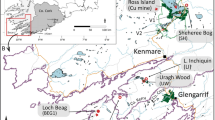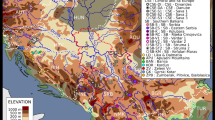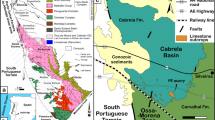Abstract
The Yongwol Group is newly defined to comprise exclusively the Cambrian-Ordovician strata distributed in Yongwol area and replaces the Yongwol-type Choson Supergroup. It consists of the Sambangsan, Machari, Wagok, Mungok and Yonghung formations in ascending order. The Yongwol Group is bounded to the east by the Kaktong thrust, to the north by the Sangri thrust, and to the northwest by the Chonggok-Yonbongjong thrust. On the other hand, the southwestern extent of the group is obscure, as the Tanyang-Chechon area is represented by metasedimentary sequence of complex stratigraphy and contrasting lithologic successions. Based on the trilobite and conodont fossils, the Yongwol Group ranges in age from the middle Middle Cambrian to the early Late Ordovician. Other Cambrian-Ordovician sequences in the Taebaeksan region are accordingly renamed or redefined: i.e., Taebaek, Yongtan, Pyongchang, and Mungyong groups which replace the Tuwibong-type, Chongson-type Pyongchang-type, and Mungyong-type Choson supergroups, respectively. The Taebaek Group is further subdivided into the Chiktong and Sangdong subgroups.
Similar content being viewed by others
References
Aoti, K., 1942, Geology of Bunkei District in Tyosen with special references to the stratigraphy of the Tyosen Group. Journal of the Geological Society of Japan, 49, 279–281. (in Japanese)
Chen, J.Y., Qian, Y.Y., Lin, Y.K., Zhang, J.M., Wang, Z.H., Yin, L.M. and Erdtmann, B.D., 1985, Study on Cambrian-Ordovician Boundary Strata and its Biotas in Dayangcha, Hunjiang, Jilin, China. China Prospect Publishing House, Bei**g, 138 p.
Chen, J.Y., Qian, Y.Y., Zhang, J.M., Lin, Y.K., Yin, L.M., Wang, Z.H., Wang, Z.Z., Yang, J.D. and Wang, Y.X., 1988, The recommended Cambrian-Ordovician global boundary stratotype of the **aoyangqiao section (Dayangcha, Jilin Province), China. Geological Magazine, 125, 415–444.
Cheong, C.H., 1969, Stratigraphy and paleontology of the Samcheog Coalfield, Gangweon-do, Korea. Journal of the Geological Society of Korea, 5, 13–54.
Cheong, C.H., Lee, D.S., Um, S.H. and Chang, K.H., 1973, A Study to Establish the Chronostratigraphic Units in Korea. Research Report R-73-5, Ministry of Science and Technology, Seoul, 68 p. (in Korean)
Cheong, C.H., Lee, D.Y., Yu, Y.S. and Kang, K.W., 1979a, Explanatory Text of the Geological Map of Pyongchang-Yongwol Sheets (1∶50,000). Korea Research Institute of Geoscience and Mineral Resources, Seoul, 19 p. (in Korean with English summary)
Cheong, C.H., Lee, H.Y., Ko, I.S. and Lee, J.D., 1979b, A study on stratigraphy and sedimentological environments of the lower Paleozoic sequences in South Korea (chiefly in Jeongseon area). Journal of the National Academy of Sciences, Republic of Korea (Natural Sciences), 18, 123–159. (in Korean)
Choi, D.K. and Jeong, K.W., 1990, Discovery of conulariid from the Yeongheung Formation (Ordovician), Korea. Journal of the Geological Society of Korea, 26, 494–499.
Choi, D.K. and Lee, D.J., 1998, Ordovician Stratigraphy and Paleontology of the Taebaegsan Region, Korea. Guidebook for IGCP 410 Field Meeting to Korea, Seoul National University, Seoul, 63 p.
Choi, D.K. and Lee, J.G., 1995, Occurrence ofGlyptagnostus stolidotus Öpik, 1961 (Trilobita, Late Cambrian) in the Machari Formation of Korea. Journal of Paleontology, 69, 590–594.
Choi, D.K., Park, G.H. and Kim, D.H., 1994, Tremadocian trilobites from the Mungog Formation, Yeongweol area, Korea. Journal of the Paleontological Society of Korea, 10, 209–223.
Choi, J.Y., 1993, Conodont Biostratigraphy and Paleoecology of the Lower Paleozoic Mungok Formation in the Yeongweolgun and Pyungchang-gun, Kangweondo, Korea. M.S. thesis, Yonsei University, Seoul, 125 p. (in Korean)
Choi, S.J. and Woo, K.S., 1993, Depositional environment of the Ordovician Yeongheung Formation near Machari area, Yeongweol, Kangweondo, Korea. Journal of the Geological Society of Korea, 29, 375–386.
Choi, Y.S., Kim, J.C. and Lee, Y.I., 1993, Subtidal flat-pebble conglomerates from the early Ordovician Mungok Formation, Korea: origin and depositional process. Journal of the Geological Society of Korea, 29, 15–29.
Chung, G.S., Paik, I.S. and Woo, K.S., 1993, The origin of dolomites in the Lower Ordovician Mungok Formation in the Yeongweol area, Kangweondo, Korea. Journal of the Geological Society of Korea, 29, 1–14.
Dean, W.T., 1989, Trilobites from the Survey Peak, Outram and Skoki formations (Upper Cambrian-Lower Ordovician) at Wilcox Pass, Jasper National Park, Alberta. Geological Survey of Canada Bulletin, 389, 1–141.
Duan, J.Y., An, S.L. and Zhao, D., 1986, Cambrian-Ordovician Boundary and its Interval Biotas, Southern Jilin, Northeast China. Changchun College of Geology, Changchun, 1–124.
Ergaliev, G.K., 1980, Trilobites of the Middle and Upper Cambrian of the Maly Karatau. Akademiya Nauk Kazakhskoy SSR, Institut Geologicheskikh Nauk, 211 p. (in Russian)
Geological Investigation Corps of Taebaeksan Region (GICTR), 1962, Report on the Geology and Mineral Resources of the Taebaegsan Region. Geological Society of Korea, Seoul, 89 p. (in Korean)
Harrington, H.J. and Leanza, A.F., 1957, Ordovician trilobites of Argentina. Department of Geology, University of Kansas, Special Publication, 1, 1–276.
Hedberg, H.D., ed., 1976, International Stratigraphic Guide—a Guide to Stratigraphic Classification, Terminology, and Procedure. John Wiley and Sons, New York, 200 p.
Hisakoshi, S., 1943, Geology of Seizen District, Kogendo, Tyosen. Journal of the Geological Society of Japan, 50, 269–277. (in Japanese)
Hukasawa, T., 1943, Geology of Heisyo District, Kogendo, Tyosen. Journal of the Geological Society of Japan, 50, 29–43. (in Japanese)
Jeong, K.W. and Choi, D.K., 1993, Trace fossils from the lower part of the Yeongheung Formation (Ordovician), Yeongweol area, Korea. Journal of the Paleontological Society of Korea, 9, 1–23.
Kano, A., Lee, D.-J., Choi, D.K. and Yoo, C.M., 1994, Ordovician (Llanvirnian) stromatoporoids from the Yeongweol area, southern Korea. Transactions and Proceedings of the Palaeontological Society of Japan, New Series, 174, 449–457.
Kim, D.H. and Choi, D.K., 1995,Kainella (Trilobita, Early Ordovician) from the Mungog Formation of Yeongweol area and its stratigraphic significance. Journal of the Geological Society of Korea, 31, 576–582.
Kim, D.H. and Choi, D.K., 1997, Tremadoc tribobites from the Mungog Formation, Yeongweol, Korea. Proceedings of 30th International Geological Congress, Vol. 11, Stratigraphy, Bei**g, August 4–14, 1996, p. 75–84.
Kim, D.H. and Choi, D.K., 1998, Additional fossils from theKainella euryrachis Zone of the Mungok Formation, Yongwol area. Annual Meeting of the Paleontological Society of Korea (Abstract with Program), Andong National University, Andong, February 25–26, p. 13. (in Korean)
Kim, I.S., Cheong, C.H. and Lee, H.Y., 1985, Trilobites from the Sambangsan Formation in the eastern side of the Pyeongchang area, Kangweon-do, South Korea. Journal of the Geological Society of Korea, 21, 45–49.
Kim, J.Y., Seo, Y.S. and Park, S.I., 1993, Occurrence ofLockeia from the Yeongheung Formation (Middle Ordovician), Yeongweol, Korea. Journal of the Geological Society of Korea, 29, 524–534.
Kim, O.J., Lee, H.Y., Lee, D.S. and Yun, S., 1973, The stratigraphy and geologic structure of the Great Limestone Series in South Korea. Journal of the Korea Institute of Mining Geology, 6, 81–114. (in Korean)
Kim, O.J., Park, P.S. and Min, K.D., 1985, Studies on geology and mineral resources of the Okchon belts—geological structure of the areas between Pyongchang, Yongwol and Jechon. Journal of the Korea Institute of Mining Geology, 18, 369–379. (in Korean)
Kobayashi, K., 1947, Geology of the Santyoku District, Kogendo, Korea. Journal of the Geological Society of Japan, 53, 616–621.
Kobayashi, T., 1935, The Cambrian-Ordovician formations and faunas of South Chosen, Part III, Cambrian faunas of South Chosen with a special study on the Cambrian trilobite genera and families. Journal of the Faculty of Science (Imperial University of Tokyo), Section II, 4, 49–344.
Kobayashi, T., 1944, Discovery ofOlenus in South Chosen. Proceedings of Imperial Academy of Tokyo, 20, p. 227–233.
Kobayashi, T., 1949, TheGlyptagnostus hemera, the oldest world instant. Japanese Journal of Geology and Geography, 21, 1–6.
Kobayashi, T., 1953, The Cambro-Ordovician formations and faunas of South Korea, Part IV, Geology of South Korea with special reference to the Limestone Plateau of Kogendo. Journal of the Faculty Science (University of Tokyo), Section II, 8, 145–293.
Kobayashi, T., 1960, The Cambro-Ordovician formations and faunas of South Korea, Part VI, Palaeontology V. Journal of the Faculty Science (University of Tokyo), Section II, 12, 217–275.
Kobayashi, T., 1961, The Cambro-Ordovician formations and faunas of South Korea, Part VIII, Palaeontology VII, Cambrian faunas of the Mungyeong (Bunkei) District and the Samposan Formation of the Yeongweol (Neietsu) District. Journal of the Faculty Science (University of Tokyo), Section II, 13, 181–241.
Kobayashi, T., 1962, The Cambro-Ordovician formations and faunas of South Korea, Part IX, Palaeontology VIII, The Machari fauna. Journal of the Faculty Science (University of Tokyo), Section II, 14, 1–152.
Kobayashi, T., 1966, Stratigraphy of the Chosen Group in Korea and South Manchuria and its relation to the Cambro-Ordovician formations of other areas, Section A, The Chosen Group of South Korea. Journal of the Faculty Science (University of Tokyo), Section II, 16, 1–84.
Kobayashi, T. and Kimura, T., 1942, A discovery of a few Lower Ordovician graptolites in South Chosen with a brief note on the Ordovician zones in eastern Asia. Japanese Journal of Geology and Geography, 18, 307–311.
Kobayashi, T., Yosimura, I., Iwaya, Y. and Hukasawa, T., 1942, The Yokusen geosyncline in the Chosen period—brief notes on the geologic history of the Yokusen orogenic zone. Proceedings of the Imperial Academy of Tokyo, 18, 579–584.
Kwon, Y.K., Chough, S.K., Lee, D.J. and Choi, D.K., 1998, Description of Mungog Formation (Lower Ordovician): Yondang Section. Field Guide Supplement II, IGCP 410 Field Meeting to Korea, Seoul National University, Seoul, 10 p.
Lee, B.S., Choi, D.K. and Lee, H.Y., 1991, Conodonts from the Machari Formation (Middle?-Upper Cambrian) in the Yeongweol area, Kangweon-do, Korea. Journal of the Geological Society of Korea, 27, 394–408.
Lee, D.J. and Yoo, C.M., 1993, Middle Ordovician stromatoporoids from the Yeongheung Formation and its biostratigraphic implication. Journal of the Paleontological Society of Korea, 9, 131–142.
Lee, H.Y., 1979, A study on the biostratigraphy and bioprovince of the Middle Ordovician conodonts from South Korea—with special reference to the conodonts from the Yongheung Formation. Journal of the Geological Society of Korea, 15, 121–150.
Lee, H.Y., 1980, Discovery of Silurian conodont fauna from South Korea. Journal of the Geological Society of Korea, 16, 114–123.
Lee, H.Y., 1982, Conodonts from the Hoedongri Formation (Silurian), western Chongson area, Kangwondo, South Korea. Journal of the National Academy of Sciences, Republic of Korea (Natural Sciences), 21, 43–131.
Lee, H.Y., 1987, Paleozoic Erathem, Choson Supergroup. In: Lee, D.S. (ed.), Geology of Korea. The Geological Society of Korea, Seoul, p. 49–82.
Lee, H.Y., Yu, K.M. and Lee, J.D., 1986, Sedimentological, stratigraphical and paleontological study on the Sambangsan Formation and its adjacent formations in the Yeongweol-Pyeongchang area, Kangweondo. Journal of the Geological Society of Korea, 22, 69–86. (in Korean)
Lee, H.Y., Lee, K.J. and Yi, M.S., 1993, Revision and addition on the Cambrian microfauna from the Kurangni area, Mungyeong-gun, Gyeongsangbuk-do, South Korea. Journal of the Paleontological Society of Korea, 9, 62–76.
Lee, J.G., 1995, Late Cambrian Trilobites from the Machari Formation, Yeongweol, Korea. Ph.D. thesis, Seoul National University, Seoul, 418 p.
Lee, J.G. and Choi, D.K., 1994,Glyptagnostus and associated trilobites from the Machari Formation, Yeongweol, Korea. Journal of the Paleontological Society of Korea, 10, 117–136.
Lee, J.G. and Choi, D.K., 1995, Late Cambrian trilobites from the Machari Formation, Yeongweol-Machari area, Korea. Journal of the Paleontological Society of Korea, 11, 1–46.
Lee, J.G. and Choi, D.K., 1996, Trilobites from thePseudoyue**ia asaphoides Zone of the Machari Formation near Gamaesil Village, Yeongweol, Korea. Journal of the Paleontological Society of Korea, 12, 145–167.
Lee, J.G., Sheen, B.C. and Choi, D.K., 1997, The Machari fauna: Middle to Late Cambrian trilobites from the Machari Formation, Yeongweol, Korea. 2nd International Trilobite Conference (Abstract with Program), Brock University, St. Catherines (Ontario), August 22–25, p. 31–32.
Lee, S.J., 1990, Conodont biostratigraphy of the lower Paleozoic Yeongheung Formation in the Yeongweol area, Kangweondo, Korea. MS thesis, Yonsei University, Seoul, 107 p. (in Korean)
Paik, I.S. and Lee, Y.I., 1989, Storm deposits of the Lower Ordovician Mungog Formation in the vicinity of Machari, Yeongweol, Kangweondo, Korea. Journal of the Geological Society of Korea, 25, 337–346.
Paik, I.S., Woo, K.S. and Chung, G.S., 1991, Stratigraphic, sedimentologic and paleontologic investigation of the Paleozoic sedimentary rocks in Yeongweol and Gabsan areas: depositional environments of the Lower Ordovician Mungok Formation in the vicinity of Yeongweol. Journal of the Geological Society of Korea 27, 357–370.
Park, K.H., Choi, D.K. and Kim, J.H., 1994, The Mungog Formation (Lower Ordovician) in the northern part of Yeongweol area: lithostratigraphic subdivision and trilobite faunal assemblages. Journal of the Geological Society of Korea, 30, 168–181.
Peng, S.C., 1990, Tremadocian stratigraphy and trilobite fauna of northwestern Human: 1. Trilobites from the Nantsinkwan Formation of the Yangtze Platform. Beringeria, 2, 1–171.
Peng, S.C., 1992, Upper Cambrian biostratigraphy and trilobite faunas of the Cili-Taoyuan area, northwestern Human, China. Memoir of the Association of Australian Paleontologists, 13, 119 p.
Pratt, B.R., 1992, Trilobites of the Marjuman and Steptoean stages (Upper Cambrian), Rabbitkettle Formation, south Mackenzie Mountains, northwest Canada. Palaeontographica Canadiana, 9, 179 p.
Reinemund, J.A., 1957, Geology of Macha-ri coalfield. U.S. Geological Survey Bulletin, 1041-C, 11–46.
Salvador, A., ed., 1994, International Stratigraphic Guide—a Guide to Stratigraphic Classification, Terminology, and Procedure (2nd edn.). International Union of Geological Sciences, Trondheim, Norway and Geological Society of America, Boulder, Colorado, 214 p.
Shergold, J.H., 1980, Late Cambrian trilobites from the Catsworth Limestone, western Queensland. Bureau of Mineral Resources of Australia, Bulletin, 186, 111 p.
Shergold, J.H., 1982, Idamean (Late Cambrian) trilobites, Burke River structural belt, western Queensland. Bureau of Mineral Resources of Australia, Bulletin, 187, 70 p.
Shergold, J.H., 1991, The Pacoota Sandstone, Amadeus Basin, Northern Territory: Stratigraphy and Palaeontology. Bureau of Mineral Resources of Australia, Bulletin, 237, 1–93.
Son, C.M., 1971, Geological system of Korea—special address at the annual meeting of the Geological Society of Korea. Journal of the Geological Society of Korea, 7, 103–116. (in Korean)
Son, C.M. and Jeong, J.G., 1971, Geology of the northwestern part of Pyeongchang District, Gangweondo, Korea. Journal of the Geological Society of Korea, 7, 143–152. (in Korean)
Son, C.M. and Jeong, J.G., 1976, On the geologic structure of Pyeongchang-Hoedong area. Journal of the National Academy of Sciences, Republic of Korea (Natural Sciences), 15, 221–245. (in Korean)
Son, C.M., Cheong, C.H., Lee, S.M. and Um, S.H., 1969a, A Study on the Sedimentary Environments and Geologic Structure of Korea. Research Report 69-2, Ministry of Science and Technology, Seoul, 50 p. (in Korean)
Son, C.M., Kim, H.S., Paik, K.H. and Lee, M.H., 1969b, Geologic structure of Yemi-Yeongweol area. Journal of the Geological Society of Korea, 5, 123–143. (in Korean)
Um, S.H., Seo, H.G., Kim, D.S., Choi, H.I., Park, S.H., Bae, D.J., Lee, H.Y., Chun, H.Y. and Kwon, Y.S., 1977, Reports on Detailed Geological Survey on the Mungyeong Coalfield. Korea Research Institute of Geoscience and Mineral Resources, Seoul, 60 p. (in Korean)
Won, M.Z. and Lee, H.Y., 1977, Age and biostratigraphy of the Mungog (Samtaesan) Formation by means of the conodont fauna. Journal of the Geological Society of Korea, 13, 97–107. (in Korean)
Woo, K.S. and Choi, S.J., 1993, Diagenetic histories of the Yeongheung Formation near Machari area, Yeongweol, Kangweondo, Korea. Journal of the Geological Society of Korea, 29, 450–463.
Woo, K.S., Chung, G.S. and Paik, I.S., 1990, Diagenetic histories of the Lower Ordovician Mungok Formation near Machari area, Yeongweol, Kangweondo, Korea: textural results. Journal of the Geological Society of Korea, 26, 350–357.
Yoo, C.M., Lee, Y.I. and Paik, I.S., 1994, Evidence for hypersaline conditions in the Middle Ordovician Yeongheung Formation, Korea. Journal of the Geological Society of Korea, 355–368.
Yosimura, I., 1940, Geology of the Neietsu District, Kogendo, Tyosen (Korea). Journal of the Geological Society of Japan, 47, 112–122. (in Japanese)
Zhou, Z.Y. and Fortey, R.A., 1986, Ordovician trilobites from North and Northeastern China. Palaeontographica Abt. A, 192, 157–210.
Zhou, Z.Y. and Zhang, J.L., 1984, Uppermost Cambrian and lowest Ordovician trilobites of North and Northeast China. Stratigraphy and paleontology of systemic boundaries in China, Cambrian-Ordovician boundary (2). Anhui Science and Technology Publishing House, Hefei, p. 61–163.
Author information
Authors and Affiliations
Additional information
In this paper Korean geographic and stratigraphic names are spelt throughout following the current system recommended by the Republic of Korea. Korean names are arranged alphabetically and their old counterparts are also given in Appendix I.
Rights and permissions
About this article
Cite this article
Choi, D.K. The Yongwol Group (Cambrian-Ordovician) redefined: a proposal for the stratigraphic nomenclature of the Choson Supergroup. Geosci J 2, 220–234 (1998). https://doi.org/10.1007/BF02910166
Received:
Accepted:
Issue Date:
DOI: https://doi.org/10.1007/BF02910166




